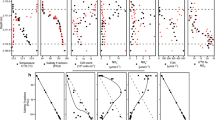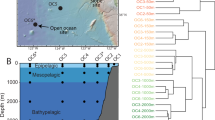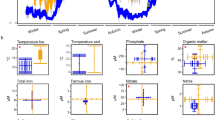Abstract
Periods of desiccation and rewetting are regular, yet stressful events encountered by saltmarsh microbial communities. To examine the resistance and resilience of microbial biofilms to such stresses, sediments from saltmarsh creeks were allowed to desiccate for 23 days, followed by rewetting for 4 days, whereas control sediments were maintained under a natural tidal cycle. In the top 2 mm of the dry sediments, salinity increased steadily from 36 to 231 over 23 days, and returned to seawater salinity on rewetting. After 3 days, desiccated sediments had a lower chlorophyll a (Chl a) fluorescence signal as benthic diatoms ceased to migrate to the surface, with a recovery in cell migration and Chl a fluorescence on rewetting. Extracellular β-glucosidase and aminopeptidase activities decreased within the first week of drying, but increased sharply on rewetting. The bacterial community in the desiccating sediment changed significantly from the controls after 14 days of desiccation (salinity 144). Rewetting did not cause a return to the original community composition, but led to a further change. Pyrosequencing analysis of 16S rRNA genes amplified from the sediment revealed diverse microbial responses, for example desiccation enabled haloversatile Marinobacter species to increase their relative abundance, and thus take advantage of rewetting to grow rapidly and dominate the community. A temporal sequence of effects of desiccation and rewetting were thus observed, but the most notable feature was the overall resistance and resilience of the microbial community.
Similar content being viewed by others
Log in or create a free account to read this content
Gain free access to this article, as well as selected content from this journal and more on nature.com
or
References
Abed RMM, Kohls K, De Beer D . (2007). Effect of salinity changes on the bacterial diversity, photosynthesis and oxygen consumption of cyanobacterial mats from an intertidal flat of the Arabian Gulf. Environ Microbiol 9: 1384–1392.
Admiraal W . (1977). Salinity tolerance of benthic estuarine diatoms as tested with a rapid polarographic measurement of photosynthesis. Mar Biol 39: 11–18.
Amalfitano S, Fazi S, Zoppini A, Caracciolo AB, Grenni P, Puddu A . (2008). Responses of benthic bacteria to experimental drying in sediments from Mediterranean temporary rivers. Microb Ecol 55: 270–279.
Apoya-Horton MD, Yin L, Underwood GJC, Gretz MR . (2006). Movement modalities and responses to environmental changes of the mudflat diatom Cylindrotheca closterium (Bacillariophyceae). J Phycol 42: 379–390.
Arrieta JM, Herndl GI . (2002). Changes in bacterial beta-glucosidase diversity during a coastal phytoplankton bloom. Limnol Oceanogr 47: 594–599.
Bellinger BJ, Abdullahi AS, Gretz MR, Underwood GJC . (2005). Biofilm polymers: relationship between carbohydrate biopolymers from estuarine mudflats and unialgal cultures of benthic diatoms. Aquat Microb Ecol 38: 169–180.
Berges JA, Franklin DJ, Harrison PJ . (2001). Evolution of an artificial seawater medium: improvements in enriched seawater, artificial water over the last two decades. J Phycol 37: 1138–1145.
Biebl H, Allgaier M, Lunsdorf H, Pukall R, Tindall BJ, Wagner-Dobler I . (2005). Roseovarius mucosus sp nov., a member of the Roseobacter clade with trace amounts of bacteriochlorophyll a. Int J Syst Evol Microbiol 55: 2377–2383.
Boschker HTS, Cappenberg TE . (1998). Patterns of extracellular enzyme activities in littoral sediments of Lake Gooimeer, The Netherlands. FEMS Microbiol Ecol 25: 79–86.
Bottner P. (1985). Response of microbial biomass to alternate moist and dry conditions in a soil incubated with 14C-labeled and 15N-labelled plant material. Soil Biol Biochem 17: 329–337.
Brown AD . (1990). Microbial Water Stress Physiology. Principles and Perspectives. John Wiley & Sons, Chichester, UK.
Chen GQ, Jiang Y, Chen F . (2008). Salt-induced alterations in lipid composition of diatom Nitzschia laevis (Bacillariophyceae) under heterotrophic culture condition. J Phycol 44: 1309–1314.
Claus D, Fahmy F, Rolf HJ, Tosunoglu N . (1983). Sporosarcina halophila sp. nov, an obligate, slightly halophilic bacterium from saltmarsh soils. Syst Appl Microbiol 4: 496–506.
Clavero E, Hernandez-Marine M, Grimalt JO, Garcia-Pichel F . (2000). Salinity tolerance of diatoms from thalassic hypersaline environments. J Phycol 36: 1021–1034.
Consalvey M, Paterson DM, Underwood GJC . (2004). The ups and downs of life in a benthic biofilm: migration of benthic diatoms. Diatom Res 19: 181–202.
Cook PLM, Veuger B, Boer S, Middelburg JJ . (2007). Effect of nutrient availability on carbon and nitrogen incorporation and flows through benthic algae and bacteria in near-shore sandy sediment. Aquat Microb Ecol 49: 165–180.
Corstanje R, Reddy KR . (2004). Response of biogeochemical indicators to a drawdown and subsequent reflood. J Environ Qual 33: 2357–2366.
Csonka LN . (1989). Physiological and genetic responses of bacteria to osmotic-stress. Microbiol Rev 53: 121–147.
Decho AW . (1990). Microbial exopolymer secretions in ocean environments: their role(s) in food webs and marine processes. Oceanogr Mar Biol Ann Rev 28: 73–153.
Dubois M, Gilles KA, Hamilton JK, Rebers PA, Smith F . (1956). Colorimetric method for determination of sugars and related substances. Anal Chem 28: 350–356.
Duran R . (2010). Marinobacter. In: Timmis KN (ed). Handbook of Hydrocarbon and Lipid Microbiology. Springer: Berlin, Germany, Vol 3, pp 1726–1734.
Elifantz H, Malmstrom RR, Cottrell MT, Kirchman DL . (2005). Assimilation of polysaccharides and glucose by major bacterial groups in the Delaware Estuary. Appl Environ Microbiol 71: 7799–7805.
Fierer N, Schimel JP, Holden PA . (2003). Influence of drying-rewetting frequency on soil bacterial community structure. Microb Ecol 45: 63–71.
Garza-Sanchez F, Chapman DJ, Cooper JB . (2009). Nitzschia ovalis (Bacillariophyceae) Mono Lake strain accumulates 1,4/2,5 cyclohexanetetrol in response to increased salinity. J Phycol 45: 395–403.
Grossart HP, Levold F, Allgaier M, Simon M, Brinkhoff T . (2005). Marine diatom species harbour distinct bacterial communities. Environ Microbiol 7: 860–873.
Guarini JM, Blanchard GF, Gros P, Gouleau D, Bacher C . (2000). Dynamic model of the short-term variability of microphytobenthic biomass on temperate intertidal mudflats. Mar Eco Prog Ser 195: 291–303.
Hallsworth JE, Yakimov MM, Golyshin PN, Gillion JLM, D’Auria G, de Lima Alves F et al. (2007). Limits of life in MgCl2-containing environments: chaotropicity defines the window. Environ Microbiol 9: 801–813.
Hanlon ARM, Bellinger B, Haynes K, Xiao G, Hofmann TA, Gretz MR et al. (2006). Dynamics of extracellular polymeric substance (EPS) production and loss in an estuarine, diatom-dominated, microalgal biofilm over a tidal emersion-immersion period. Limnol Oceanogr 51: 79–93.
Haynes K, Hofmann TA, Smith CJ, Ball AS, Underwood GJC, Osborn AM . (2007). Diatom-derived carbohydrates as factors affecting bacterial community composition in estuarine sediments. Appl Environ Microbiol 73: 6112–6124.
Hofmann T, Hanlon ARM, Taylor JD, Ball AS, Osborn AM, Underwood GJC . (2009). Dynamics and compositional changes in extracellular carbohydrates in estuarine sediments during degradation. Mar Ecol Prog Ser 379: 45–58.
Hoppe HG . (1983). Significance of exoenzymatic activities in the ecology of brackish water: measurements by means of methylumbelliferyl substrates. Mar Ecol Prog Ser 11: 299–308.
Huettel M, Forster S, Kloser S, Fossing H . (1996). Vertical migration in the sediment-dwelling sulfur bacteria Thioploca spp. in overcoming diffusion limitations. Appl Environ Microbiol 62: 1863–1872.
IPCC (2007). Summary for policymakers. In: Solomon S, Qin D, Manning M, Chen Z, Marquis M, Averyt KB, Tignor M, and Miller HL (eds). Climate Change 2007: The Physical Science Basis. Contribution of Working Group I to the Fourth Assessment Report of the Intergovernmental Panel on Climate Change. Cambridge University Press: Cambridge, UK.
Jurgens K, Pernthaler J, Schalla S, Amann R . (1999). Morphological and compositional changes in a planktonic bacterial community in response to enhanced protozoan grazing. Appl Environ Microbiol 65: 1241–1250.
Kaczmarska I, Ehrman JM, Bates SS, Green DH, Leger C, Harris J . (2005). Diversity and distribution of epibiotic bacteria on Pseudo-nitzschia multiseries (Bacillariophyceae) in culture, and comparison with those on diatoms in native seawater. Harmful Algae 4: 725–741.
Kieft TL, Soroker E, Firestone MK . (1987). Microbial biomass response to a rapid increase in water potential when dry soil is wetted. Soil Biol Biochem 19: 119–126.
King GM . (1986). Characterization of beta-glucosidase activity in intertidal marine sediments. Appl Environ Microbiol 51: 373–380.
Kirchman DL . (2002). The ecology of Cytophaga-Flavobacteria in aquatic environments. FEMS Microbiol Ecol 39: 91–100.
Kirst GO . (1990). Salinity tolerance of eukaryotic marine algae. Annu Rev Plant Physiol Plant Mol Biol 41: 21–53.
Kosanke JW, Osburn RM, Shuppe GI, Smith RS . (1992). Slow rehydration improves the recovery of dried bacterial populations. Can J Microbiol 38: 520–525.
Kromkamp J, Barranguet C, Peene J . (1998). Determination of microphytobenthos PSII quantum efficiency and photosynthetic activity by means of variable chlorophyll fluorescence. Mar Ecol Prog Ser 162: 45–55.
Labrenz M, Collins MD, Lawson PA, Tindall BJ, Schumann P, Hirsch P . (1999). Roseovarius tolerans gen.nov., sp.nov., a budding bacterium with variable bacteriochlorophyll a production from hypersaline Ekho Lake. Int J Syst Bacteriol 49: 137–147.
Lee ZM, Bussema C, Schmidt TM . (2009). rrnDB: documenting the number of rRNA and tRNA genes in bacteria and archaea. Nucleic Acids Res 37: D489–D493.
Lorenzen CJ . (1967). Determination of chlorophyll and phaeopigments: spectrophotometric equations. Limnol Oceanogr 12: 343–346.
Manh HD, Matsuo Y, Katsuta A, Matsuda S, Shizuri Y, Kasai H . (2008). Robiginitalea myxolifaciens sp.nov. a novel myxol-producing bacterium isolated from marine sediment, and emended description of the genus Robiginitalea. Int J Syst Evol Microbiol 58: 1660–1664.
Nausch M, Kerstan E . (2003). The relationship between dissolved carbohydrates and carbohydrate-degrading enzymes in the salinity gradient of the Pomeranian Bight (southern Baltic). Oceanologia 45: 437–452.
Neufeld JD, Schafer H, Cox MJ, Boden R, McDonald IR, Murrell JC . (2007). Stable-isotope probing implicates Methylophaga spp and novel Gammaproteobacteria in marine methanol and methylamine metabolism. ISME J 1: 480–491.
Oxborough K, Hanlon ARM, Underwood GJC, Baker NR . (2000). In vivo estimation of the photosystem II photochemical efficiency of individual microphytobenthic cells using high-resolution imaging of chlorophyll a fluorescence. Limnol Oceanogr 45: 1420–1425.
Perkins RG, Oxborough K, Hanlon ARM, Underwood GJC, Baker NR . (2002). Can chlorophyll fluorescence be used to estimate the rate of photosynthetic electron transport within microphytobenthic biofilms? Mar Ecol Prog Ser 228: 47–56.
Porter D, Roychoudhury AN, Cowan D . (2007). Dissimilatory sulfate reduction in hypersaline coastal pans: activity across a salinity gradient. Geochim Cosmochim Acta 71: 5102–5116.
Potts M . (1999). Mechanisms of desiccation tolerance in cyanobacteria. Eur J Phycol 34: 319–328.
Roberson EB, Firestone MK . (1992). Relationship between desiccation and exopolysaccharide production in a soil Pseudomonas sp. Appl Environ Microbiol 58: 1284–1291.
Rothrock MJ, Garcia-Pichel F . (2005). Microbial diversity of benthic mats along a tidal desiccation gradient. Environ Microbiol 7: 593–601.
Round FE, Crawford RM, Mann DG . (1990). The Diatoms, Biology and Morphology of the Genera. Cambridge University Press: Cambridge.
Sakamoto T, Yoshida T, Arima H, Hatanaka Y, Takani Y, Tamaru Y . (2009). Accumulation of trehalose in response to desiccation and salt stress in the terrestrial cyanobacterium Nostoc commune. Phycological Res 57: 66–73.
Sauer J, Wenderoth K, Maier UG, Rhiel E . (2002). Effects of salinity, light and time on the vertical migration of diatom assemblages. Diatom Res 17: 189–203.
Saum SH, Muller V . (2008). Regulation of osmoadaptation in the moderate halophile Halobacillus halophilus: chloride, glutamate and switching osmolyte strategies. Saline Syst 4: 4.
Schafer H, Abbas B, Witte H, Muyzer G . (2002). Genetic diversity of ‘satellite’ bacteria present in cultures of marine diatoms. FEMS Microbiol Ecol 42: 25–35.
Schimel J, Balser TC, Wallenstein M . (2007). Microbial stress-response physiology and its implications for ecosystem function. Ecology 88: 1386–1394.
Simon M, Grossart H-P, Schweitzer B, Ploug H . (2002). Microbial ecology of organic aggregates in aquatic ecosystems. Aquat Microb Ecol 28: 175–211.
Smith BM, Melis A . (1988). Photochemical apparatus organization in the diatom Cylindrotheca fusiformis: photosystem stoichiometry and excitation distribution in cells grown under high and low irradiance. Plant Cell Physiol 29: 761–769.
Smith DJ, Underwood GJC . (1998). Exopolymer production by intertidal epipelic diatoms. Limnol Oceanogr 43: 1578–1591.
Stal LJ, Vangemerden H, Krumbein WE . (1984). The simultaneous assay of chlorophyll and bacteriochlorophyll in natural microbial communities. J Microbiol Methods 2: 295–306.
Tamaru Y, Takani Y, Yoshida T, Sakamoto T . (2005). Crucial role of extracellular polysaccharides in desiccation and freezing tolerance in the terrestrial cyanobacterium Nostoc commune. Appl Environ Microbiol 71: 7327–7333.
Teramoto H, Nakamori A, Minagawa J, Ono T . (2002). Light-intensity-dependent expression of Lhc gene family encoding light-harvesting chlorophyll-a/b proteins of photosystem II in Chlamydomonas reinhardtii. Plant Physiol 130: 325–333.
Underwood GJC . (1994). Seasonal and spatial variation in epipelic diatom assemblages in the Severn estuary. Diatom Res 9: 451–472.
Underwood GJC . (1997). Microalgal colonization in a saltmarsh restoration scheme. Estuar Coast Shelf Sci 44: 471–481.
Underwood GJC . (2002). Adaptations of tropical marine microphytobenthic assemblages along a gradient of light and nutrient availability in Suva Lagoon, Fiji. Eur J Phycol 37: 449–462.
Underwood GJC, Kromkamp J . (1999). Primary production by phytoplankton and microphytobenthos in estuaries. Adv Ecol Res 29: 93–153.
Underwood GJC, Paterson DM . (2003). The importance of extracellular carbohydrate production by marine epipelic diatoms. Adv Bot Res 4: 183–240.
Underwood GJC, Perkins RG, Consalvey MC, Hanlon ARM, Oxborough K, Baker NR et al. (2005). Patterns in microphytobenthic primary productivity: species-specific variation in migratory rhythms and photosynthetic efficiency in mixed-species biofilms. Limnol Oceanogr 50: 755–767.
Underwood GJC, Phillips J, Saunders K . (1998). Distribution of estuarine benthic diatom species along salinity and nutrient gradients. Eur J Phycol 33: 173–183.
van Bergeijk SA, Van der Zee C, Stal LJ . (2003). Uptake and excretion of dimethylsulphoniopropionate is driven by salinity changes in the marine benthic diatom Cylindrotheca closterium. Eur J Phycol 38: 341–349.
van Oevelen D, Middelburg JJ, Soetaert K, Moodley L . (2006). The fate of bacterial carbon in an intertidal sediment: modeling an in situ isotope tracer experiment. Limnol Oceanogr 51: 1302–1314.
Vila-Costa M, del Valle DA, Gonzalez JM, Slezak D, Kiene RP, Sanchez O et al. (2006). Phylogenetic identification and metabolism of marine dimethylsulfide-consuming bacteria. Environ Microbiol 8: 2189–2200.
Whale GF, Walsby AE . (1984). Motility of the cyanobacterium Microcoleus chthonoplastes in mud. Brit Phycol J 19: 117–123.
Williams JP, Hallsworth JE . (2009). Limits of life in hostile environments: no barriers to biosphere function? Environ Microbiol 11: 3292–3308.
Acknowledgements
We thank Tania Cresswell-Maynard and John Green for invaluable technical support. This work was funded by a grant to GJCU and TJM from the UK Natural Environment Research Council (NE/D003598/1).
Author information
Authors and Affiliations
Corresponding author
Ethics declarations
Competing interests
The authors declare no conflict of interest.
Additional information
Supplementary Information accompanies the paper on The ISME Journal website
Supplementary information
Rights and permissions
About this article
Cite this article
McKew, B., Taylor, J., McGenity, T. et al. Resistance and resilience of benthic biofilm communities from a temperate saltmarsh to desiccation and rewetting. ISME J 5, 30–41 (2011). https://doi.org/10.1038/ismej.2010.91
Received:
Revised:
Accepted:
Published:
Issue date:
DOI: https://doi.org/10.1038/ismej.2010.91
Keywords
This article is cited by
-
Aquatic phases have a stronger effect on lotic benthic diatoms than human-induced microhabitat variability
Hydrobiologia (2024)
-
Diatom community response to inland water salinization: a review
Hydrobiologia (2023)
-
Diversity of GH51 α-L-arabinofuranosidase homolog sequences from subantarctic intertidal sediments
Biologia (2023)
-
Small rain events during drought alter sediment dissolved organic carbon leaching and respiration in intermittent stream sediments
Biogeochemistry (2022)
-
Experimental desiccation indicates high moisture content maintains hyporheic biofilm processes during drought in temperate intermittent streams
Aquatic Sciences (2021)



